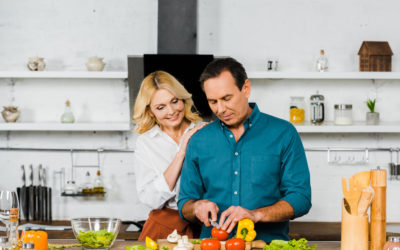The way we use makeup changes throughout our life. And the products we use should also change accordingly. As our skin starts showing our experiences and wisdom, we need to treat it with even more respect and enhance it even further. Forget about those heavy creamy or powdery makeup products, and switch to lighter more liquid solutions. Do you want to get more in-depth about the nitty details? Keep reading!
Once you’ve passed 50, you can sum up the essential aspects of make-up in two words: Luminosity and understatement. Some tricks for successful make-up.
- You have been using a concealer against eye shadows for a long time? You can stay true to it if you use a liquid version (in an applicator, brush, or sponge) instead of the stick version. Half a shade lighter than foundation, apply a very small amount like an eye concealer. Spread a pinhead-sized amount with the brush and dabbing with your fingertips: if you use more, the product may settle into the lines… which will further accentuate them.
- Just like concealer, complexion primer should remain light and discreet. Prefer a so-called BB cream to mask-like, thick make-up – which may accentuate the wrinkles you actually want to conceal. Blemish balm has a more natural result, and does several jobs at once: it moisturizes, protects the skin from the environment, and makes the complexion appear more even by tinting the cream. If you opt for a CC cream (ColourControl), this version works like a corrective make-up base and conditions at the same time. It adapts to your individual skin tone and corrects it. Correcting pigments act like the “primers” you apply before your complexion foundation: purple for a sallow complexion, yellow for dark circles, green for redness, and orange for a fresh complexion.
- Don’t forget that too much powder makes the skin look older. Apply just a touch with a large, well-tapped brush. Sweep lightly over the face from the inside out. The best choice for a fresh complexion? A powder with a pink undertone that makes your skin glow. However, if you are prone to redness, it is better to avoid pink tones.
- Rouge makes you look rested and youthful. Choose a colour that matches your skin tone exactly and use it sparingly. A creme rouge blends perfectly with your skin and looks natural. Light colours give your face youthful radiance and emphasise your facial contours. The texture should be matte rather than shimmering; the pearlescent particles settle into the creases. Apricot and pink tones are best, forget about browns which make you look sallow. Cremerouge is applied after foundation (or BB or CC cream) and before powder. Apply blush to the highest point of your cheekbones with your fingertips.
- Over time, eyelids become droopy, so applying make-up to the eyes should visually open them up. Eye shadow is best chosen in neutral tones, carefully smudged. Then use a kohl pencil, a “dry” one rather than a creamy one, which lasts better and does not run. The eyeliner should not be too black and thick, otherwise, the look will be hard and the eyelids heavy. With age, eyelashes also become thinner. Resist the temptation to try to compensate with several thick layers of mascara. This causes the lashes to stick together. Rather use lengthening mascara!
- Like complexion and blush, lips are more favourably accentuated with lighter shades. The darker shades, from the brown and burgundy colour range, make the mouth appear hard and the lips narrow. The lighter shades, such as pink and apricot, make the lips look fuller. If your lips are very narrow, apply a little lip gloss to the centre of the lower lip. You also need to be careful with lip liners: forget about ones that are darker than your lipstick. The ideal contour pencil is matte and either matches the natural colour of your lips or is the same shade as your lipstick. Carefully trace the contour of your lips and then spread the colour, just the contour pencil or the lipstick, with a lip brush from the outside inwards










